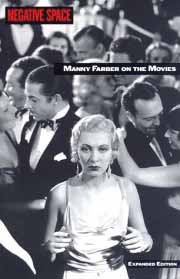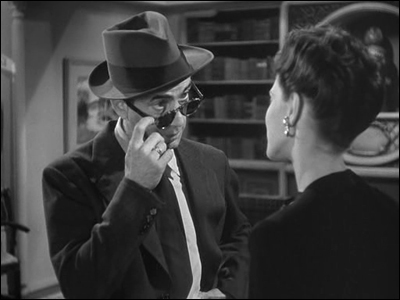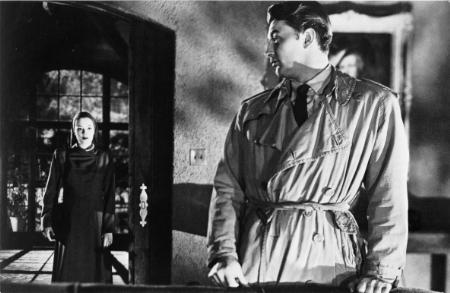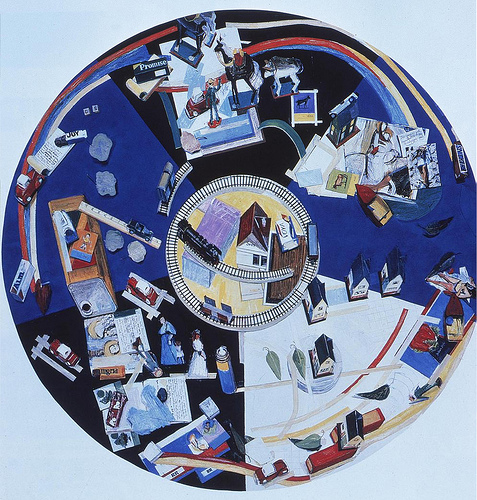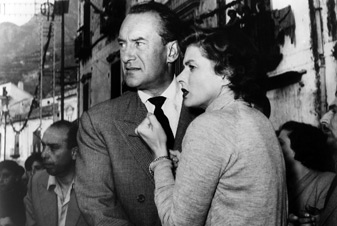From the May 12, 2000 issue of the Chicago Reader. –J.R.
Negative Space
Rating *** A must see
Directed and written by Chris Petit
With Robert Mitchum, Manny Farber, Dave Hickey, and (as narrator) Petit.
There aren’t many films or videos about film criticism, especially ones that perform the actual work of film criticism. An interesting and ambitious exception is Chris Petit’s Negative Space (1999), an experimental 39-minute video made for BBC TV that’s being shown for free by Chicago Filmmakers at the Chicago Cultural Center this Friday, along with Petit’s The Falconer (1998). Named after the only book by film critic, painter, and teacher Manny Farber — a 1971 collection reprinted in an expanded edition in 1998 — Petit’s video wrestles with American landscape and culture, irony, memory, Las Vegas, the beginning of a new millennium, death, desert, film versus video, J.M.W. Turner’s painting, several movies (including Howard Hawks’s The Big Sleep, Jacques Tourneur’s Out of the Past, and Roberto Rossellini’s Voyage to Italy), as well as two critics, Farber and Dave Hickey. Petit also looks at Farber as a painter and an art critic and Hickey as an art critic, a resident of Las Vegas, an appreciator of Farber, and a commentator on American culture. It’s far too hefty an agenda for 39 minutes. But the epigrammatic intensity of Farber’s example emboldened Petit to try, and it’s amazing how much he manages to include without giving the sense that he’s cramming it in.
Farber’s capacity to capture a complex subject — an era, an iconographic gesture or event or detail, a multifaceted stylistic comparison — in one pithy phrase has inspired many of his disciples to swagger their way through arguments with comparable poetic generalizations, and Petit is more adept at this practice than most. Paradoxically, in spite of Farber’s macho ambition to hit descriptive bull’s-eyes with punchy prose during his 35 years as a published critic (1942-’77), his words were probably never excerpted in print ads for any movie. It’s entirely to his credit that his writing, unlike that of every other American film critic, could never be mistaken for or converted into advertising of any kind. In part that’s because it isn’t always obvious whether he’s praising or heaping ridicule and abuse on an actor, director, or film moment.
For a sampling of recent observations from Farber about favorite filmmakers, notably Abbas Kiarostami and Maurice Pialat, Kent Jones’s profile in the March-April issue of Film Comment is invaluable. But Petit’s video — the first time Farber has ever appeared on-screen, notwithstanding extended homages to him and his work such as Jean-Pierre Gorin’s feature-length essay Routine Pleasures (1986) [see below] and Paul Schrader’s short film Untitled: New Blue (1995) — is after something more. It’s a meditation that explicates Farber’s positions and applies them to aspects of the American landscape and of movies in general.
In 1976, when I was working for two government-supported publications in London, Monthly Film Bulletin and Sight and Sound, I wrote to several film departments in the U.S. looking for a teaching job, hoping to negotiate a way back to the States after seven years abroad. A favorable response arrived from Farber, my favorite American film critic then and now, who offered me a job replacing him at the University of California at San Diego while he took a sabbatical; at that point we’d spoken on the phone once, in 1969 when we were both living in New York, but had never met. At the time, Chris Petit, another Farber fan, was a London colleague of mine who reviewed movies for Time Out and hoped to become a filmmaker. After I moved to San Diego in 1977, he drove down one day from Los Angeles, where he was trying to sell a script, to visit me and to meet Farber.
Twenty-two years later, when Petit — a filmmaker since 1979, a novelist since 1993 — came to the Locarno film festival with The Falconer [see above], we found ourselves staying at the same hotel and had breakfast together one morning. He asked me for Farber’s current phone number, and I recommended he read Air Guitar, a recent collection of essays by another American critic, Dave Hickey, most of them about music and painting.
Almost six months later I went to the world premiere of Negative Space (then with the working title “Dead Cinema”) at a sparsely attended screening at the Rotterdam film festival. I certainly can’t claim that anything in the video was made according to any suggestions of mine. For one thing, I’ve never met Hickey, and Petit’s decision to use him as a talking head and not as a writer in no way corresponds to my own enthusiasm for Hickey’s prose. Despite the aptness and imagination of some of Hickey’s remarks in the video — such as his comparison of the everyday tempo of Las Vegas with Luchino Visconti’s The Leopard — he often registers as a raucous blowhard compared to the more stoical Petit and Farber, and his nervous laughter often threatens to undercut his arguments. (I suspect this is more Petit’s fault than Hickey’s, but it’s the only serious flaw in the video that I can think of.)
Furthermore, Petit’s collaboration with Farber worked out extremely well for both, but my relationship to Farber has been somewhat variable (a subject I explored in my book Placing Movies). And my contact with Petit since the 70s has been minimal, though last year he did send me a 14-minute video he made in 1994 about a mutual friend, writer Rudy Wurlitzer, about whom I was writing an essay.
I’m bringing all this up in the interest of full disclosure. But I don’t think it’s any more relevant to my opinion of Petit’s video than my interest in film criticism or my biases in the film-versus-video debate.
Before Farber is even mentioned in Negative Space, Petit is reasonably up-front about some of his own interests. At the beginning we see Petit and his wife driving from an interview with Hickey in Las Vegas to an interview with Farber in Leucadia, a San Diego suburb — more precisely, we see Petit’s unnamed wife driving through Las Vegas and desert country while Petit [see below] — who doesn’t appear anywhere in Negative Space, though he narrates throughout — tapes her driving their rented car.
Over a grainy, hard-to-read clip from a black-and-white Hollywood movie and color footage of Las Vegas taped from the car, Petit telegraphs his concerns: “America — sheer physical space, no irony, no metaphor, distance no object.” Then, over a procession of home-video landscapes shot from a moving car and framed like old-fashioned Polaroids — labeled “Highway 195,” “Highway 93 Arizona,” “Highway 111 Salton Sea,” “Highway 86 Salton Sea,” “Lakeshore Rd, Las Vegas,” and “Highway 62” — we hear Petit saying, “Bastrop, Texas; Phoenix, Arizona; Las Vegas, Nevada; Leucadia, California. Itinerary instead of narrative. Movement, space, and light rather than words on a page. Eight dollars of gas to cross three states. Driving insane distances for the hell of it. After the cramped spaces of Europe, emotional and physical, America feels wide open and literal. The road becomes a movie, becomes the memory of other movies. The physical space of the country reflected in its movie stars, who always knew how to move.” We hear some dialogue from Out of the Past, then see as well as hear a brief clip featuring a romantic clinch, which eventually leads into discussions of Robert Mitchum and of Farber’s 1962 essay “White Elephant Art vs. Termite Art,” extolling the virtues of throwaway “termitic” filmmaking (including Out of the Past and The Big Sleep) in relation to the more pretentious “ambitions towards gilt culture” of “white elephant” Oscar winners.
Petit goes on to analyze Farber’s brief analysis of Humphrey Bogart crossing the street in The Big Sleep (“one of the finest moments in 1940’s film is no longer than a blink: Bogart as he crosses the street from one bookstore to another, looks up at a sign”) and some of the special virtues of his criticism (“When he described movies, he didn’t pay attention to the story but wrote instead about the more interesting stuff: speed, light, the way an actor walked, the tempo of the movie, and, above all, space”). After getting Farber, now in his mid-80s, to expand on certain points, Petit comes up with a very suggestive thesis of his own about American space: “Of course the stumbling block for Europeans in America is, as they’re constantly reminded, the American failure to understand irony — as though it matters. First, this is probably not true; and out west, anyway, they don’t need it — they have space and they have gaze and horizon; they don’t need the artificial distance of irony. Real space and real emptiness make such conceits redundant. Irony and desert operate as polar extremes.”
The Polaroid-like framings in the opening segment of Negative Space function not as a passing conceit but as a central strategy. They frequently allow Petit to chop up his images — his film clips and his videotaped travels and interviews –and to juxtapose two of them on the screen, either simultaneously or serially. Sometimes he uses two separate cropped images from the same shot in Rossellini’s Voyage to Italy. At one point he makes room for a video exploration of The Joyces Felt Humiliated [see below], a 1983 Farber painting inspired by the Rossellini film, following a clip from the film itself and footage of Farber talking about it. At another point he creates a rhyme effect between a sugar dispenser at a roadside diner in Out of the Past and a similar object in Farber’s studio. More generally he uses these images as a means of metaphorical expansion: many of the film scenes cited by Farber (in Psycho, Breathless, Contempt, and Voyage to Italy) involve looking out of windows or through windshields, and Petit often juxtaposes these shots with views through his own car windows or windshield. Similarly, his focus on movie stars like Mitchum or George Sanders and Ingrid Bergman (in Voyage to Italy) is echoed by his focus on Farber and Hickey as performers.
Petit is also concerned in his narration with the degradation and loss of film images when they’re put on video or simply forgotten — which in his terms often amounts to the same thing. And he commingles his own implied brooding about the “death” of cinema with the actual deaths of Mitchum, Sanders, and Bergman as well as Farber’s allusions to his own death. Endlessly provocative, this video represents just the kind of experimental work we could never hope to see on American television, despite its all-American focus — presumably because we Americans lack the proper amount of irony to deal with such matters.


